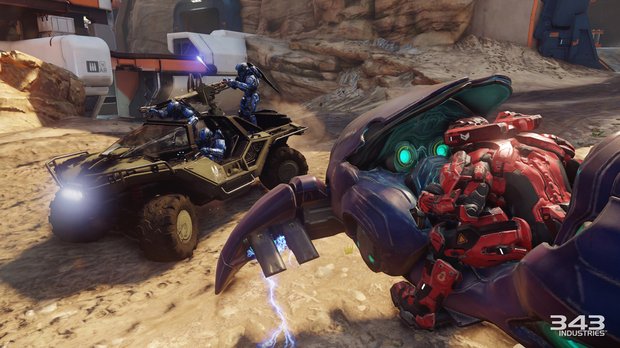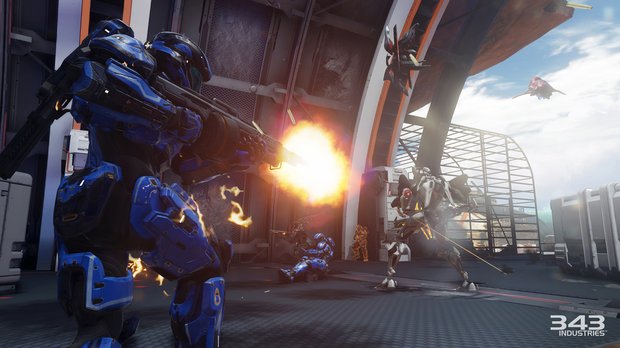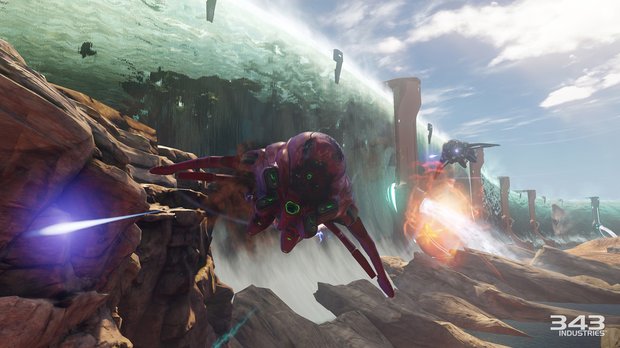Halo 5s Warzone is a race to 1000 points
Halo 5’s Warzone mode doesn’t care how many kills you get. They’re not worthless, not when dealt in the right time and place. But as a currency they amount to pennies dropped in the Warzone bank. 343 has devised an escalating battle economy for 24 players, with two teams clashing over resources on a wide field of play. And sometimes those resources fight back.

There’s a quick and dirty way to unpack Warzone: It’s deathmatch when you’re trying to evict the other team from a critical base. It’s territory control when you want to keep that base. It’s vehicular combat when you summon a Warthog or a Banshee from the building’s bowels. It’s a digital cousin to Halo: Reach’s Invasion mode when you want to build momentum and claim the next base. It’s co-op when you and your team fight a powerful, computer-controlled boss on the way. And it’s team deathmatch when the other team has the same idea. Oh, and they also have a Banshee? Great.
Game marketing has taught me to classify all these features like commodities and genres, like I have to break Warzone down as bits and pieces of Halo scattered across a Battlefield map, mixed with tug-of-war objectives, seasoned with MOBA-like enemy farming, something something bad cooking metaphor. It’s all true when wiped clean of nuance, but the breakdown isn’t nearly as interesting as the composition.

The simple goal of 1,000 points - reach it before the other team does – helps a lot in organizing Warzone’s geographically scattered pockets of violence. Within these, whether you’re helping clear out a base for your teammates, or helping a friend destroy a Covenant Hunter on the other side of the map, helps move your 12-person pendulum in the overall war.
Even tiny victories can spin out to large gains later. Killing one spartan on the other team barely gets you any points, unless that spartan was the last thing keeping a base contested. When ownership rolls over to your team, you start earning points and additional energy, which you’ll exchange for better weapons and bigger, airborne vehicles. The terminal inside each base, which also becomes a respawn point under your tenure, instantly dispenses assault rifles, rocket launchers and the lot if you can afford them. When you purchase a vehicle from it, you’re instantly warped to it and shoved out the door.
Now you have the means to hassle the other team, push to the next base (usually three per map) or easily wipe out the wave of AI-controlled Prometheans the game just sent in. Now that one kill, that tiny investment, is paying off.

There are a couple of other wrinkles in Halo 5’s biggest bout of red vs. blue, including match-ending target cores that open up when a team spends too much time being dead, but none that make the chaos unreadable. In fact, for how many objectives there can be, from spontaneous co-op battles to bitter fights over that middle base, it’s remarkable that Warzone doesn’t feel disorienting or haphazardly paced.
Weekly digests, tales from the communities you love, and more
I’m not in a position to describe how well Halo 5 is balancing all of Warzone’s components – that’s going to take more than a few matches – but the big picture works.

Ludwig Kietzmann is a veteran video game journalist and former U.S. Editor-in-Chief for GamesRadar+. Before he held that position, Ludwig worked for sites like Engadget and Joystiq, helping to craft news and feature coverage. Ludwig left journalism behind in 2016 and is now an editorial director at Assembly Media, helping to oversee editorial strategy and media relations for Xbox.


